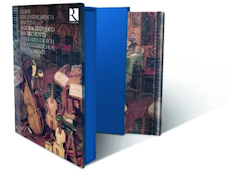
The Internet's Premier Classical Music Source
Related Links
-
Introduction
Acoustics
Ballet
Biographies
Chamber Music
Composers & Composition
Conducting
Criticism & Commentary
Discographies & CD Guides
Fiction
History
Humor
Illustrations & Photos
Instrumental
Lieder
Music Appreciation
Music Education
Music Industry
Music and the Mind
Opera
Orchestration
Reference Works
Scores
Thematic Indices
Theory & Analysis
Vocal Technique
Search Amazon
Recommended Links
Site News
 Book Review
Book Review
Guide To Period Instruments

Various Contributors
Ricercar RIC100
ISBN: 0439001005
ISBN-13: 5400439001008
The enterprising Belgium group which includes Ricercar has published an attractive, useful and comprehensive new book, Guide To Period Instruments. No single author is credited for this well-presented and illustrated 200-page volume, which comes with eight CDs containing illustrative examples culled mostly from 30 years of recordings by Ricercar, although some have been specially produced. The book is arranged by instrument family: strings (bowed, plucked); wind (woodwind, "using lip pressure", brass); keyboard (plucked, struck and blown); and percussion. Each section is then subdivided into historical periods. Although most early music enthusiasts will want to use it as a reference encyclopedia, the entries are written with enough of a narrative tone for it also to be possible to read the book from beginning to end.
There is a short general introduction which starts in Graeco-Roman antiquity. Then, each period (Medieval, Renaissance, Baroque and Classical) is dealt with family by family. The CDs, on the other hand, follow the chronological span of the book sequentially – also from the Medieval to the Classical period (Rossini). The quality of the extracts is more than adequate to illustrate each instrument's salient features and differences. Although short almost by definition (none lasts more than much under nine minutes), to play your way through these 186 examples would be an interesting experience for what it reveals about the history of musical instruments.
The entries are generally short: few are longer than half a page; most are accompanied by a color photograph (of extant originals) and/or contemporary manuscript(s) or drawings. Each family is introduced discretely. Where families (such as the trumpet) have had separate phases of development. they are dealt with exhaustively. And relationships, changes, evolution and similarities that were maintained (and lost) are all clearly outlined and cross-referenced. There are, though, a couple of slight drawbacks to the way entries are arranged in the three languages supported in Guide To Period Instruments.
In the first, place it lacks a Table of Contents with which quickly (and repeatedly) to orientate yourself. There is a simple index; though this has entries in French, English and German interleaved so that you can look up an instruments by the name you're most familiar with… Dessus de viole, treble viol or Diskantgambe, for example. Some entries (such as "Alto") could have been more closely proof-read and mean little. The decision so to arrange text one language after the other for each instrument or grouping of instruments (families) reveals the second snag: it's not always clear what the equivalents are since the text is often set around a graphic. Once you become used to the horizontal lines which delineate the start and end of entry groups, though, that ceases to impede usage too much. This arrangement has clearly been used to keep costs down… the triplication of high quality graphics would have pushed the cost of the publication (including the CDs) way above the very reasonable price for which it does retail. To have clear illustrations of the mainstream (like the lutes, archlutes, theorbo/chitarrone, mandolin and cittern) and more out of the way (vihuela, ceterone/bass cittern, mandora, bandora, penorcon and orpharion) instruments from the centuries to 1800 is most useful.
In their sturdy cardboard fold-out packaging the 200-page book and eight CDs are almost eight by six inches and over two inches thick. The standard of production is high, the paper glossy; though those dimensions mean that most of the illustrations – surely one of the most important aspects of such a book – tend to be smaller than might have been wished. Nor, given the compromises with layout already mentioned, is it always so clear as it might be which (version of the) text refers to which illustration. This doesn't detract unduly from the usefulness of the encyclopedia, though.
If you need a brief history of the evolution of the shawm into the oboe, for example, and when each of the resultant oboes were most used and what their varying characteristics (keys; materials from which they are commonly made; use as solo, accompanying, ensemble or continuo instrument etc) are, then you'll easily find it here. Although there is scant bibliographical or source referencing, the reader of each example is directed to the corresponding track(s) on the relevant CD(s). A dozen or so pages at the back of the book aggregate the examples on the CD with player credits and sources. A further five pages list the several hundred photographic credits.
General music lovers would certainly find the Guide To Period Instruments en eye-opener, thanks to its comprehensiveness and authority. Specialists too. And those just curious – just what is the difference between the spinet, virginal, clavichord and harpsichord? – will quickly find answers here. Faults there are, but they're few enough and compensated for by the many advantages of this publication for it to be worth a look.
Copyright © 2010 by Mark Sealey.


















